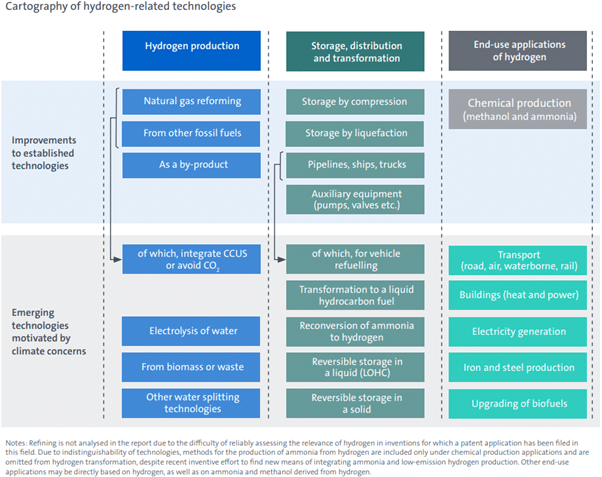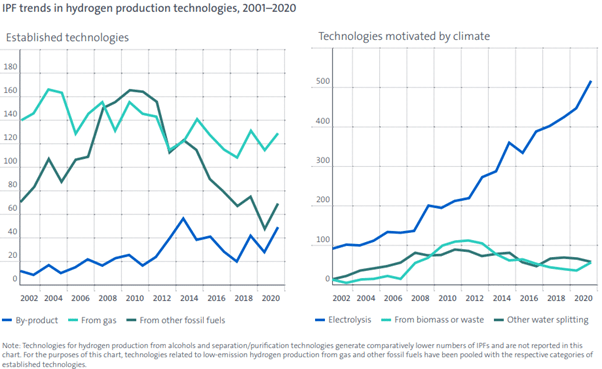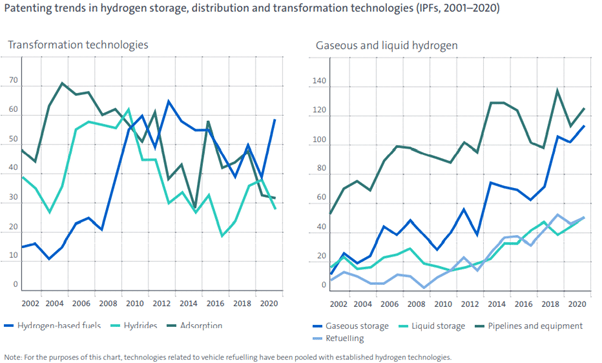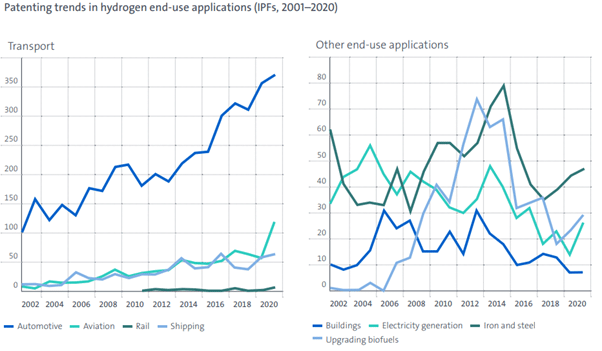Global Innovation Trends Along the H2 Value Chain
Hydrogen is the most abundant element in the universe, and for many years has promised to play a significant role in clean energy solutions. Its sheer abundance alongside its clean combustion products would suggest hydrogen is an ideal candidate to liberate us from our fossil fuel dependency. It is, however, important to consider the entire hydrogen value chain when assessing its viability as a clean energy source. The value chain can be broadly segmented into three key fields: production, storage and distribution, and end use application. The European Patent Office (EPO) and International Energy Agency (IEA) recently issued a report analysing the global trends of innovation along hydrogen value chains. The existing and emerging technologies corresponding to each stage of the value chain can be seen in the figure below, which comes from the EPO/IEA report.
Today, approximately 95 % of hydrogen is produced from fossil fuel sources through processes such as natural gas reforming. This process is not only still dependent on fossil fuels for raw materials, but requires significant energy input, which is also commonly derived from fossil fuels.
Production
Electrolysis is an alternative means of hydrogen production, which does not require fossil fuels as a raw material, but currently accounts for an exceedingly small proportion of global production (around 0.04 % in 2021). This process involves the use of electricity to decompose water molecules into hydrogen and oxygen. Whilst electrolysis appears promising, the process is currently only around 75 % efficient and more than 99 % of the total hydrogen production by electrolysis is produced using energy from non-renewable sources.
The EPO/IEA global trend analysis found that hydrogen production technologies accounted for the largest number of hydrogen related patents in the 2011 to 2020 period. Technologies motivated by climate concerns generated nearly 90 % of International Patent Families (IPFs) related to hydrogen production in 2020. With a strong focus on decarbonising hydrogen production, there has been a rapid increase in electrolysis related patents and a substantial decrease in patent applications for hydrogen production from fossil fuels. These trends are visible in the figure below from the EPO/IEA global trend analysis report.
With high natural gas prices, the economic climate has shifted in favour of low-emission hydrogen from electrolysis, attracting further investment. It is clear that further innovation is necessary to enable renewable, low carbon hydrogen production and while several families of electrolysers of vastly differing technical maturity are under concurrent development, there is still no consensus on a preferred solution.
Storage and Distribution
Pure hydrogen is currently transported in pipelines and tube trailers as a gas or in cryogenic tanks in its liquefied form. To fully exploit the potential of hydrogen as a fuel, efficient, standardised, and cost-effective means of storage and transport is imperative.
Current hydrogen storage and transport remains the subject of many challenges, such as the substantial weight and volume of storage systems, energy losses associated with compression and liquefication, and durability of storage systems. Patent trends across hydrogen transport and storage can be seen in the figure below from the EPO/IEA report, which shows a strong focus on infrastructure to support hydrogen uptake.
Unlike hydrogen production technologies, universities and research organisations account for very few of the patent applications for the storage and transport of hydrogen. This suggests this portion of the hydrogen value chain is predominantly based on mature technologies with a focus on incremental innovation. However, some emerging technologies, such as the use of liquid organic hydrogen carriers or synthetic methane, have shown promise for future large-scale deployment.
Application
Whilst this article has focused heavily on hydrogen as an alternative fuel, hydrogen demand is primarily driven by the chemical industry, of which around 75 % was directed to ammonia production and around 25 % for methanol production. Innovation in the hydrogen sector, accelerated by an appetite for clean energy, will likely result in greater efficiency of the existing hydrogen supply chain and thus decrease the carbon footprint of the entire industry.
Emerging hydrogen applications and patenting trends are focused heavily on transport, with more IPFs for automotive applications of hydrogen since 2001 than for all other emerging uses of hydrogen combined. Fuel cells appear to be the most mature technology for hydrogen powered transport, with some market uptake already. Alternatives such as hydrogen internal combustion engines are of demonstrable capacity and lag slightly behind the maturity of fuel cell technology. Hydrogen powered solutions for road and rail are significantly more refined than their air transport counterparts, with scalability and the mass of hydrogen storage posing significant challenges in aviation. Patent trends across hydrogen applications can be seen in the figure below from the EPO/IEA report, which shows a strong focus on the automotive sector.
Challenges still persist with on-board vehicle storage of hydrogen as well as how to convert the chemical energy from hydrogen into motive force. Within the automotive and aviation sectors, patent applications for means of propulsion dominate. In particular, hydrogen fuel cells account for a significant portion of innovation in the last decade. For aviation, it is expected that fuel cells may be viable for shorter haul journeys. For longer haul flight, it is expected that the higher power of turbines and energy density of hydrogen-based fuels will offer greater performance than the combination of a fuel cell and motor.
Where Next?
It is apparent from the EPO/IEA global trend analysis that hydrogen remains a focus for innovation across the world. To fully exploit hydrogen as the clean energy source of the future, innovation is necessary throughout the value chain to ensure efficient, cost-effective, and sustainable practice from production through to end-use application.
We all rely on innovators to provide us with the technology to progress towards a hydrogen-powered future. Investment in new technologies is key to further commercial success and more than 80 % of late-stage investment in hydrogen start-ups in 2011 to 2020 went to companies that had filed a patent application in areas such as electrolysis, fuel cells, or low-emissions methods for producing hydrogen from gas.
Forresters specialises in providing clear direction to innovators as they seek crucial legal protection for their IP and enable the implementation and commercialisation of their ideas. We look forward to contributing to a sustainable future by supporting innovators with practical and valuable IP advice.
Author: Elliot Farrell, Forresters, Liverpool, United Kingdom, lcroft@forresters-ip.com





























0 Comments